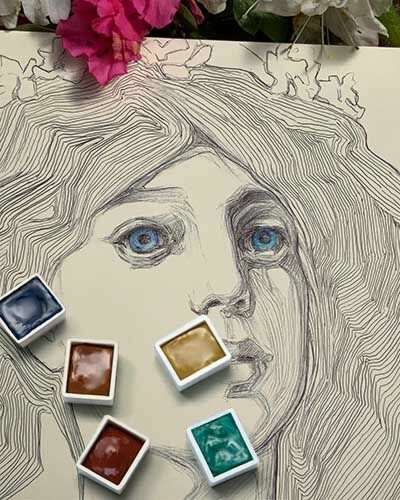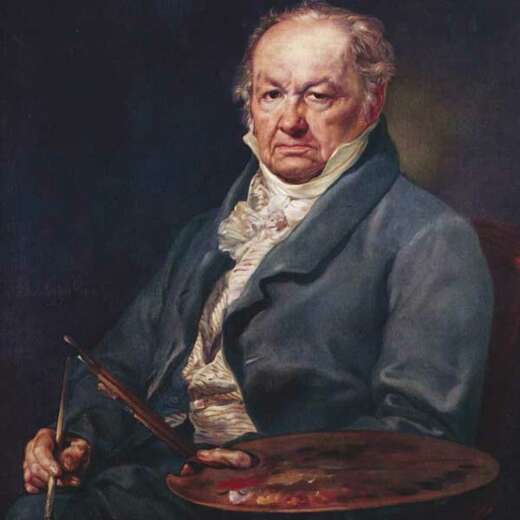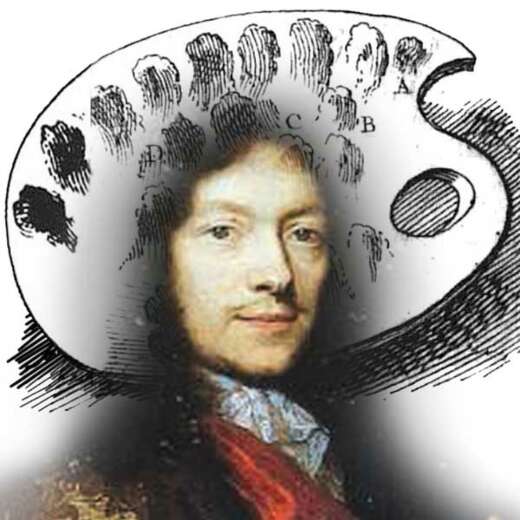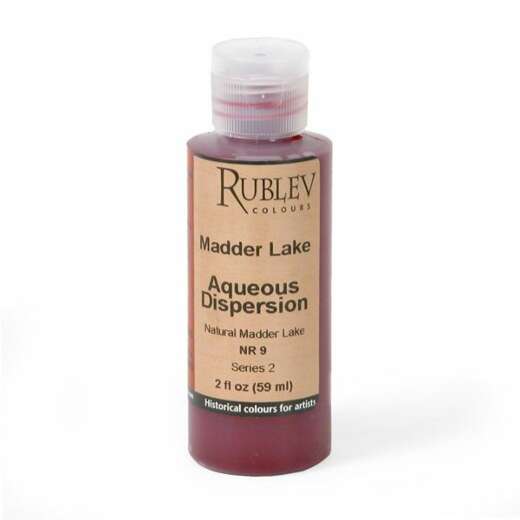
Now Painting Best Practices is online.
|
Workshop Quick Links
Schedule
Reviews
Where Taught
Curriculum
Instructors
Register
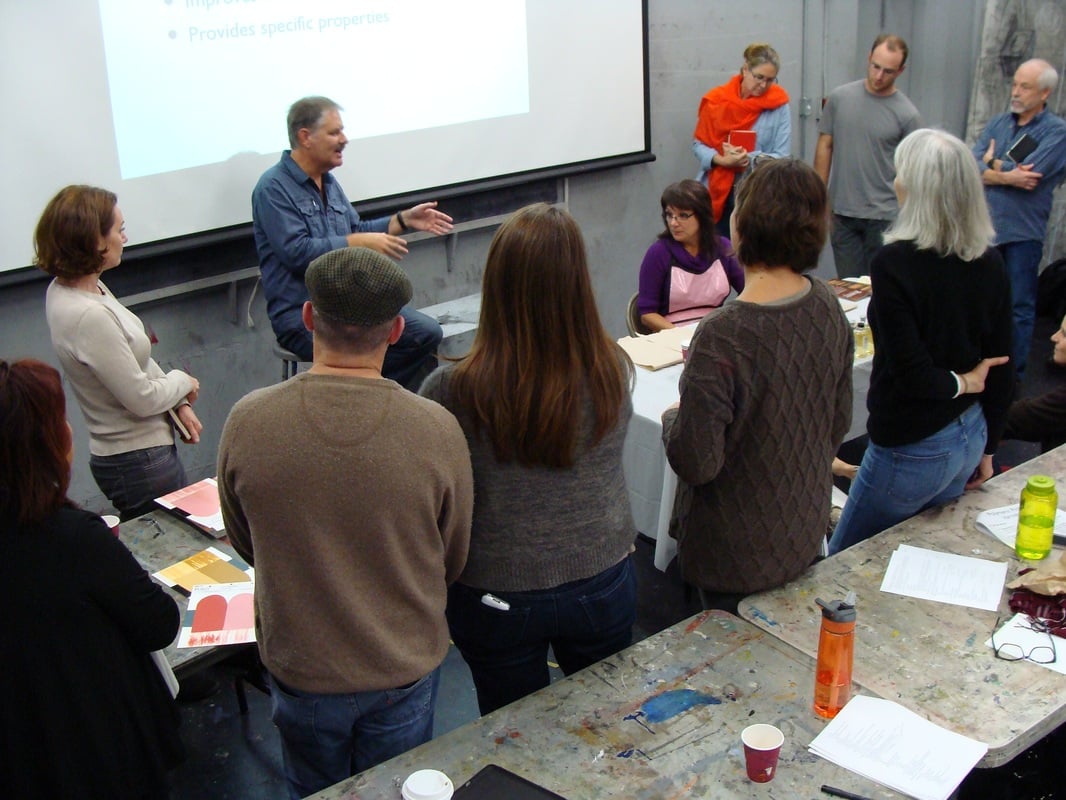
Attendees of the Painting Best Practices workshop gather to see a demonstration of paint optical principles at the Gage Academy of Art in Seattle, Washington.
Tuition
Workshop Tuition: USD 450 per person
Note: Tuition for workshops in Europe are higher.
We have launched Painting Best Practices to provide this vital training and skills in an online course.
About the Workshop
Workshop Hours are typically from 9:00 a.m. to 5:00 p.m. each day of the workshop. The last day of the workshop may end earlier than 5:00 p.m.
What’s the Format of the Workshop?
The workshop consists of lectures accompanied entirely by projected digital images, questions and answers, and art materials demonstrations. We encourage you to ask questions throughout the workshop.
You are welcome to photograph the projection screen during the workshop, but only for your personal use; do not distribute the images to others due to copyright infringement. Please, no audio or video recordings during the workshop.
What’s Required?
There is no need to bring supplies except a pen or pencil and a notebook. We will distribute several printed handouts on the first day of the workshop, but you will want to take copious notes during the workshop. One student made over 20 pages of notes at a workshop.
Are Lodging and Meals Provided?
Natural Pigments does not provide lodging and meals. Restaurants and eateries are usually not far from workshop locations, and we provide a one-hour lunch break from about 12 noon to 1:00 p.m. each day.
Who are the Instructors?
George O’Hanlon, Technical Director of Natural Pigments
Tatiana Zaytseva, Administrative Director of Natural Pigments
Workshop Reviews
Read Matthew Innis’s extensive review of this workshop in Underpaintings. This is an online magazine that is worth the annual subscription. Natural Pigments endorses Underpaintings magazine as one of the top online resources about painting and visual art.
Read Amanda Teicher’s two-part review of this workshop in her blog, Amanda Teicher Fine Art. Read the first part and the second part of her review. Amanda creates oil paintings in the realist tradition, focusing on portraiture and still life.
Necessary and excellently delivered—Painting Best Practices is a workshop that addressed questions I have had about my practice for years and, due to Mr. O’Hanlon’s clear and genuine love for art and concern with its best possible development and preservation, the information was faultlessly structured and exceptionally well delivered. I have filled a whole book with copious notes.
—Jo Fraser, London
Thank you for an excellent workshop. Your knowledge is awe-inspiring. I now have a good foundation of knowledge to begin changing my methods and materials. Also, I will talk to the GCA and see if we can have you bring the workshop to our students! (Note: The Grand Central Academy was so enthusiastic about the workshop that they engaged the instructor to teach it to all their students.)
—Joshua La Rock, instructor, Grand Central Academy, New York
I took this workshop last fall and found it so rich in information that I want to offer it to my students.
—Koo Schadler, Alstead, New Hampshire
Thanks for all the excellent information—that was a tremendous workshop!
—Louie Lane, artist assistant to Cecily Brown, New York
I just wanted to send you my little blog post about our weekend at the Painting Best Practices workshop. Doug and I had a wonderful time and truly appreciate the depth and quality of your workshop.
—Jody Mattison, Antioch, California
Great workshop. Pat and I came away feeling that what we learned would have taken years. But you did it for us on a weekend! Appreciate your “obsession” and what you have learned and conveyed to us. I am serious—write a book!
—Jerzy Niedojadlo, Nitram Fine Art Charcoal
I enjoyed your workshop and reported it enthusiastically to my teachers at the Academy of Realist Art, Boston.
—David Valbracht, Boston

Tony Curanaj (far left) and Edward Minoff (near left) interview George O’Hanlon (far right), as Tatiana Zaytseva (center), co-founder of Natural Pigments, keeps close tabs on the Podcast production.
The latest Suggested Donation podcast features a geek-out on artist’s materials with George O’Hanlon, technical director and founder of Natural Pigments. The podcast was recorded at the Grand Central Academy of Art on the heels of his workshop on painting best practices. Jay Braun brings his audio engineering pyrotechnics to the table.
Listen to the Suggested Donation podcast.
Where the Workshop Has Been Taught
Natural Pigments has taught hundreds of artists technical information regarding artists’ materials and painting techniques at these workshop locations:
Lyme Academy of Art, Old Lyme, Connecticut
October 21–23, 2022
Studio Incamminati, Philadelphia, Pennsylvania
October 14–16, 2022
Florence Academy of Art, Jersey City, New Jersey
September 27–29, 2019
Blue Rooster Art Supplies, Los Angeles, California
March 8–10, 2019
Laguna College of Art & Design, Laguna Beach, California
October 5–7, 2018
American Women Artists, Lodi, California
July 30–August 1, 2018
Chiascuro Atelier, Doral, Florida
April 13–15, 2018
Florence Academy of Art, Jersey City, New Jersey
April 6–8, 2018
Craft Guild of Dallas, Carrollton, Texas
March 5–7, 2018
Malibu Creative Arts Studio, Malibu, California
October 20–22, 2017
The Art Academy, St. Paul, Minnesota
June 26–28, 2017
Vitruvian Fine Art Studio, Chicago, Illinois
June 23–25, 2017
ARTiculations, Toronto, Ontario, Canada
June 16–18, 2017
The Art League, Alexandria, Virginia
June 12–14, 2017
Alia Fine Art Studios, Raleigh, North Carolina
June 8–10, 2017
Wethersfield Academy of Art, Wethersfield, Connecticut
April 13–15, 2017
The Florence Academy of Art, Jersey City, New Jersey
April 7–9, 2017
Southern Atelier, Sarasota, Florida
November 18–20, 2016
Fountainhead Artspace, Roswell, Georgia
November 11–13, 2016
Scottsdale's Artist School, Scottsdale, Arizona
October 15–7, 2016
Sadie Valeri Atelier, San Francisco, California
May 23–25, 2016
The Conservatory for Classical Art, Edmond, Oklahoma
May 9–11, 2016
Beaufort Art Market, Beaufort, North Carolina
April 19–21, 2016
New Museum Los Gatos, Los Gatos, California
February 19–21, 2016
Tony Ryder Studio, Santa Fe, New Mexico
October 29–31, 2015
Los Angeles Academy of Figurative Art, Los Angeles, California
October 23–25, 2015
Articulations, Toronto, Ontario, Canada
September 19–21, 2015
Rochester Art Club, Rochester, New York
September 15–17, 2015
Grand Central Atelier, Queens, New York
September 11–13, 2015
Russian River Atelier, Geyserville, California
August 22–24, 2015
Justin Hess Studios, San Francisco, California
July 11–12, 2015
Sadie Valeri Atelier, San Francisco, California
May 29–31, 2015
Townsend Atelier, Chattanooga, Tennessee
April 24–26, 2015
Studio Incamminati, Philadelphia, Pennsylvania
April 10–12, 2015
Ani Art Academy, Bear Creek Village, Pennsylvania
April 7, 8, 2015
Cloud Castle Art Studio, Saratoga, California
January 23–25, 2015
Eastside Artists Collaborative, Bellevue, Washington
November 7–9, 2014
Gage Academy of Art, Seattle, Washington
November 4–6, 2014
Electric Zoo, Saint Petersburg, Florida
October 3–5, 2014
Kadmium Art + Design, Sydney, New South Wales, Australia
September 12–14, 2014
Natural Pigments, Willits, California
August 15–17, 2014
Vicki Walsh Studio, San Diego, California
June 21–23, 2014
Koo Schadler Studio, Alstead, New Hampshire
June 8–9, 2014
Golden Gate Atelier, Oakland, California
May 9–11, 2014
Grand Central Academy of Art, New York, New York
April 3–4, 2014
Grand Central Academy of Art, New York, New York
April 1–2, 2014
Grand Central Academy of Art, New York, New York
March 28–30, 2014
Accent Arts, Palo Alto, California
March 15–16, 2014
Center for Academic Study and Naturalist Painting, Springville, Utah
March 6–8, 2014
Oregon Society of Artists, Portland, Oregon
February 28–March 2, 2014
Peggy Nichols Studio, Los Angeles, California
October 12–13, 2013
Articulations, Toronto, Ontario, Canada
September 28–29, 2013
DoubleTree Hotel, Fort Lee, New Jersey
September 21–22, 2013
Natural Pigments, Willits, California
August 24–25, 2013
Introduction
Most causes of paint failures have been studied for over a hundred years: humidity, temperature, and paint embrittlement. The symptoms were obvious—cracking, delaminating, and paint loss—but the causes were not. Conservation workers gradually formed concepts about the causes of cracking and paint loss in old paintings. Concurrently, the coatings industry studied failures in all types of paint films. Artists developed their ideas but remained largely unaware of findings from the conservation community and the coatings industry.
Natural Pigments spent years developing a technical workshop to teach skills not taught in art schools and universities—a thorough understanding of artists’ materials and tools, what they are designed to do, when to choose them, and how to provide considerable longevity to your finished work. This workshop covers the most important aspects of painting that have proven to be the best practices over the centuries.
The information-packed workshop includes all aspects of constructing a painting, from the support and ground to the final layers. Practical procedures are clearly explained and demonstrated in building your oil paintings based on conservation research during the past century. This workshop is designed for painters of all mediums, but particular emphasis is given to oil painting.
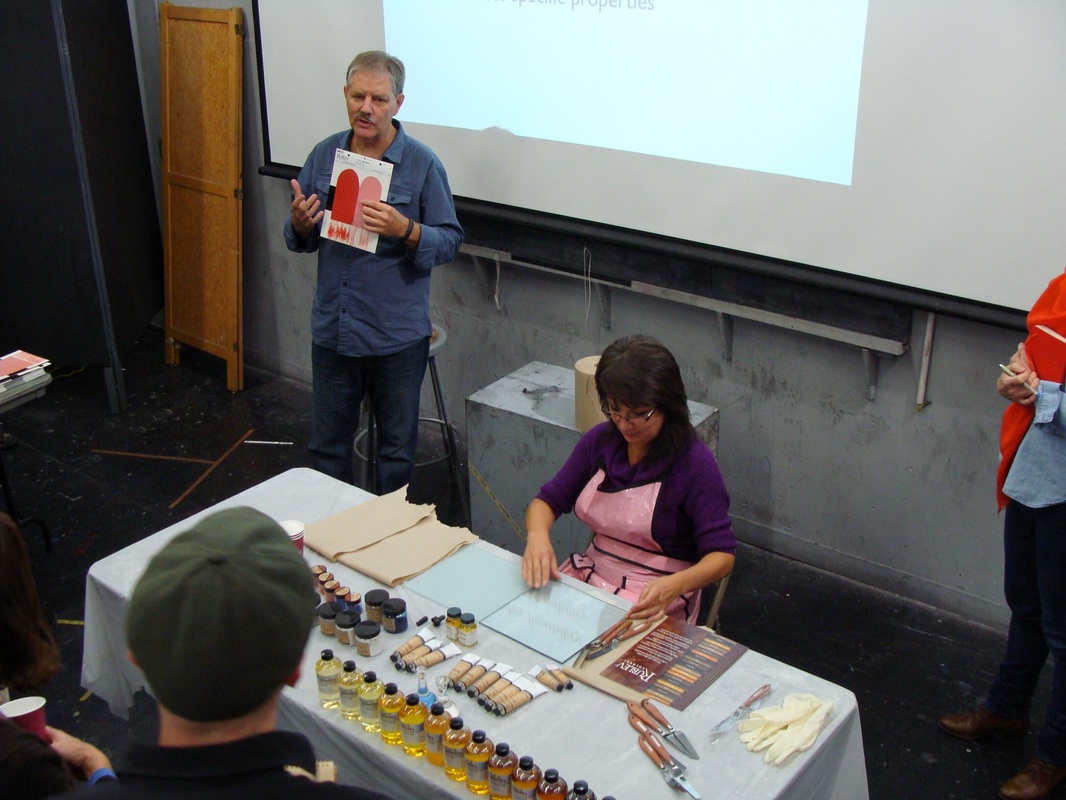
Tatiana Zaytseva prepares to demonstrate paint making while George O’Hanlon discusses optical differences between lead and titanium white in mixtures at the Gage Academy of Art.
Workshop Curriculum
The workshop begins with a review of the leading causes of cracking and paint loss in paintings. In light of the research, we review different painting supports to help you choose the best one for your painting technique. We review the most suitable grounds for each type of popular support and painting and review factors influencing the embrittlement of the paint film and what artists can do to prolong its life. Throughout the workshop, we provide recommendations involving different supports, grounds, and painting techniques to help you make technically sound paintings.
Day 1
Supports and Grounds
The foundation of all painting are supports. Substrates of fabric, wood, plaster, metal, glass, and plastic have all been used at one time or another as supports for paintings. We examine the most popular supports today and the advantages and disadvantages of each type.
We review how wood panels were made historically and the methods employed to prevent warping. We examine manufactured wood panels, such as fiberboard and plywood, and separate the myth from reality. You will be taught how to prepare wood panels properly, learn the most effective braces, and why standard methods do more harm than good.
In recent years, artists have rekindled interest in copper as a painting support. You will be introduced to its advantages and learn how to properly prepare copper panels for painting. You will also learn about aluminum composite materials (ACM), such as Dibond, where to obtain them, how to prepare them for painting directly on them, and how to adhere them to canvas.
Since the sixteenth century, stretched canvas supports have enjoyed immense popularity. They are also a major cause of cracking in paintings. You will learn the advantages and disadvantages of the various stretched fabrics—linen, cotton, and polyester canvas. We will examine the auxiliary supports of stretched canvas—strainers and stretchers—constructed of wood, metal, or plastic. You may be surprised to learn how keys—small wooden wedges inserted into the corners of the stretchers for expansion—do more harm than good. You will learn of sources for high-quality stretchers. We will teach you how to produce perfectly aligned canvases, regardless of size. We will show the benefits of pre-stretching your canvas before attaching it to your support, allowing it to reach equilibrium and lock the fibers. We will also demonstrate a technique for stretching the perfect canvas, creating even tension across the entire surface, avoiding the distracting undulations in the fabric weave, and pulling the stretchers out of alignment. We will examine the advantages and disadvantages of staples versus tacks and which types to use and avoid.
Finally, we will show you an efficient approach to backing your stretched canvas to protect the back of the fabric from substantial changes in humidity, dirt, pests, and the damage often caused during transport and hanging.
Sizes and Grounds
Next, you will learn to size your canvas and prime your panel. We’ll show how to make and apply animal glue size, avoiding excessive amounts, and discuss the advantages of modern alternatives, such as PVA and acrylic dispersions.
After carefully preparing the support, we are ready to apply the ground. Whether it’s traditional gesso, acrylic primer, oil grounds, emulsion grounds, or double grounds, you will learn how to apply a ground that provides a solid and lasting foundation for your painting. We examine the different grounds and how they affect the longevity of your finished painting.
Day 2
Paints and Mediums
We focus on the basics of paints. We examine in detail the mechanism of oil drying, the characteristics of various drying oils, such as linseed, walnut, poppy, and safflower oil, and how their properties affect the behavior of paint. We examine the drying times of these various oils to help you properly layer your painting to avoid sunken passages and drying wrinkling and cracking. You will learn what the oft-misused principle of “fat-over-lean” really means, how it is more flexible than most would suppose, and how it relates to oil painting mediums. You will understand it well enough to know how to use it in your painting.
Optical and Physical Properties of Paint
We next examine the four aspects of light and optics on a paint film: reflection, refraction, absorption, and diffraction. You’ll learn why varnishes change the appearance of paint, why titanium dioxide makes colors appear chalky in mixtures, why oil colors become more transparent with age, and why manufacturers add zinc oxide to many commercial oil colors.
Paint Components and Their Effect on Paint Behavior and Appearance
We next demonstrate how to make your paint using oil, pigment, and additives that can aid handling. You will have the opportunity to prepare oil paint. This is a skill that every artist should master. We will also discuss the properties of synthetic and natural resins used in commercial oil painting mediums and their advantages and disadvantages. In addition to making oil paint, we will also make tempered paints, such as egg tempera, distemper (glue tempera), or casein.
We correct misinformation surrounding solvents and the confusion created by the bewildering trade names, such as Turpenoid. We will discuss the various common diluents, such as gum turpentine (and the terms “triple distilled,” “rectified,” etc.), mineral spirits, and spike oil. All have their uses, which is when you will learn what those uses are and when to take advantage of them.
We also discuss additives that slow or speed up drying, such as metal driers (cobalt, lead, zirconium, and calcium). We solve the puzzle about the use of varnishes and mediums prepared with natural resins, such as dammar, mastic, copal, Venice turpentine, and Canada balsam, present in oil painting, how they are used to produce special effects in paint and their disadvantages.
We will demonstrate the proper technique of “oiling out” and painting into a “wet cushion” to unify color between paint layers and provide a non-slip surface for subsequent paint layers.
Day 3
Varnishes
A varnish can serve several functions, technical as well as purely visual. The decision to apply varnish to a picture is made after careful consideration of many factors and cannot be reduced to a formulaic approach. If a varnish is to be applied, many decisions must be considered, such as type, method of application, and desired final appearance. We will demonstrate how to apply a varnish properly and avoid defects commonly found in its appearance.
Brushes
We begin the day’s session by examining the typical anatomy of an artist’s brush. We examine the many different natural and synthetic hairs used in today’s brushes and how each type provides different sensations and effects in the hands of artists. The names for hair used by manufacturers are often confusing and sometimes even misleading. We identify what each name typically denotes, such as Kolinsky and Sable, and help you to identify them. Besides the hair’s quality, the brush’s construction—the handle, ferrule, and glue used to hold the hair in place—determines its quality and service life. We show how brushes are made and provide the details you need to evaluate them before you purchase them.
Understanding Art Materials and Labeling
In this session, we discuss existing standards for paints and artists’ materials and what they mean for the artist. The lightfastness of many pigments has been tested, but do the ratings apply to the same pigment across different paint brands? Why is one pigment lightfast in oil paint but not in watercolors or pastels? Why is it important for artists to be aware of the ingredients used in paint? What do the different codes and terms on the labels signify, such as PR 102 or Pigment Red 102? We dispel the many myths surrounding artists’ materials, correct misunderstandings, and give you the information to make informed choices about paint and artists’ materials. We also show you how to perform basic lightfastness tests of paint in your studio because your personal use and application of paint can affect its lightfastness.
What pigment interactions are beneficial in paint mixtures, and which are not? We present several hundred years of observations by the old masters and current conservation studies to answer questions about pigment mixtures and how to avoid adverse reactions and interactions that cause fading, browning, or darkening in paint.
Pigments
We next discuss common pigment types, such as inorganic, organic, natural, and synthetic pigments, and other classifications of pigments used in painting. We simplify the chemistry of pigments so you understand their makeup, origin, and modern sources. You will learn about the lightfastness, compatibility, and durability of historical and modern oil, tempera, and watercolor pigments and their interactions, drying, and aging in these mediums.
Studio Safety
We discuss studio safety and health practices to help artists achieve a clean and safe working environment that promotes health and safety. In this session, we focus on the proper disposal of artists’ materials, protective gear, and clothing for different studio tasks, studio ventilation, working procedures that help to avoid contaminating living areas, and inexpensive and easy methods of testing for heavy metals on work surfaces, floors, and tools.
Instructors
George O’Hanlon
George O’Hanlon is the technical director of Natural Pigments and executive director of Iconofile, a nonprofit educational organization dedicated to promoting the understanding of sacred art. George received his fine arts education and apprenticeship in Mexico. Upon his return to the United States, he worked as an art director and then creative director for Silicon Valley advertising agencies, working on major accounts like Sony, Hewlett-Packard, and Ricoh. He then established a marketing communications firm later acquired by the Japanese chemical giant, Shin-Etsu, where we were retained as president of U.S. marketing operations. In 1992, he left this post to study traditional art techniques, and then in 2001, he founded Iconofile and Natural Pigments to promote an understanding of these techniques among contemporary artists. Since then, he has formulated hundreds of artists’ paints and materials, including Ceracolors, a water-soluble wax paint.
Tatiana Zaytseva
Tatiana Zaytseva is the administrative director of Natural Pigments and secretary of Iconofile, a nonprofit educational organization dedicated to promoting the understanding of sacred art. Tatiana received her education in fashion and design in Saint Petersburg, Russia, and a second degree in engineering process controls. After moving to the U.S. in 2001, she helped establish Iconofile and Natural Pigments in 2003.
Do You Want this Workshop for Your School or Atelier?
If you or your school would like to schedule a workshop in your local area, please call 1-888-361-5900 to learn more about how this can be arranged. We are already scheduling workshops at private schools and ateliers in the U.S. and Canada.
Register Now
This workshop will provide more information on the craft of painting than most art students learn in four years of art school.
The limited class size (not to exceed 25) allows each attendee to receive personal attention and have questions answered specific to their needs. Due to the limited class size, we ask that you register early and pay for the workshop upon registration.
Workshop Tuition: USD 450 per person
Note: Tuition for workshops in Europe may be higher.
Cancellations
If you cancel the workshop, please note that the tuition is non-refundable. If you cannot attend the workshop, you will be given a rain check to attend a workshop at the same or different location. If we cancel the workshop, your tuition will be refunded entirely.
Have questions? Call 1-888-361-5900 from 9:00 a.m. to 5:00 p.m. Pacific Time (PST) Monday through Friday.



